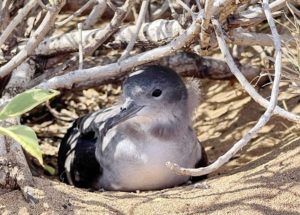
A Kaena Point Wedge-tailed Shearwater chick at the entrance of its burrow, Thursday, November 11, 2021 © Craig Thomas
November 15, 2021
This month, the departure and arrival areas are busy at Open Ocean Airways: Our wedgies are leaving and our albies are returning.
Wedgies are Wedge-tailed Shearwaters, ʻUaʻu kani, native seabirds that arrive in Hawaii in spring to mate, lay an egg under a bush or in an underground burrow. After the baby hatches, parents spend the day fishing, returning each evening to feed their chick.
Come November, parents stop feeding their baby. When it gets hungry, the youngster moves to its burrow opening, and in the dark of night, takes it first flight to the ocean. The young remain at sea until they reach sexual maturity in 3-to-5 years. The birds then come ashore, look for a mate and start raising their own chick. The oldest recorded wedgie lived for 29 years, but they may live longer.
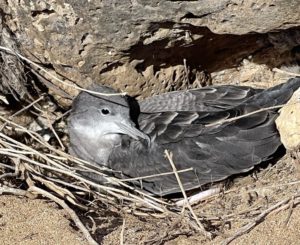
Another Kaena Point wedgie chick, November 11, 2021 ©Susan Scott
Wedgie chicks find the ocean by heading for moon and star reflection on the water’s surface. In the darkness of the Kaena Point Natural Reserve, wedgie chicks usually find the ocean just fine. But when leaving from tiny nearby islands, most of which are predator-free seabird sanctuaries, they often fly toward street and house lights, hit power lines, and fall to the ground.
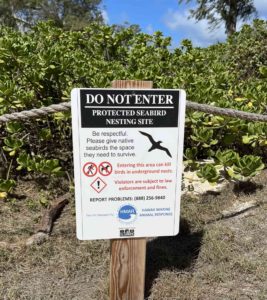
Although most wedge-tailed shearwaters nest in seabird protected areas, some choose open areas on the main Hawaiian Islands. Here, the birds are vulnerable to cats, dogs, mongooses and rats. Kailua Beach Park. ©Susan Scott
This so-called “fallout” isn’t always fatal. Sometimes the bird is only stunned and confused. Caring people who find a downed wedgie on the ground can often save it. Public and private agencies have organized rescue systems for helping our stranded young wedgies.
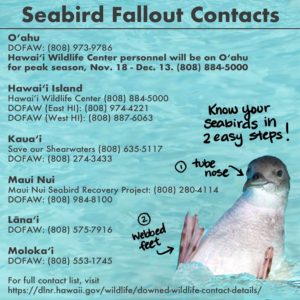
This charming video by Oikonos Ecosystem Knowledge illustrates what to do if you find a wedgie: youtube.com/watch?v=5L4E8FaCo_
You don’t have to save this post to find help. An Internet search using the words seabird fallout will bring up phone numbers for your area.
As our wedgies leave, our albies, or albatrosses, are returning to land to start their own chick rearing. Laysan Albatrosses, Mōlī, arrive here in November from the open ocean. Mature birds land near their annual nesting spot, and wait for their lifetime mate to return. When the two are reunited, they get down to the business of continuing their species. The oldest Laysan Albatross, Midway’s famous Wisdom, is at least 70 years old.
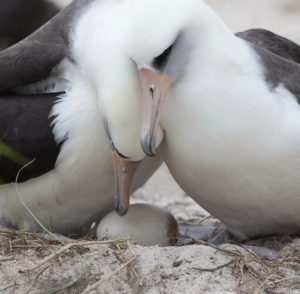
Albatrosses mate for life, with parents taking turns to sit on their egg and feed their chick. ©Susan Scott
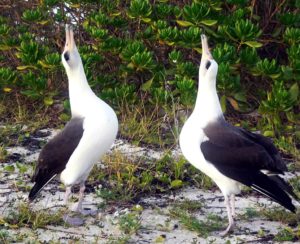
Established albatross couples don’t waste time singing and dancing, but singles do (above) as they look for Mr. and Ms. Right. The loud, exuberant rituals of unmated individuals continue all winter, while parent albatrosses go about their business of raising chicks. ©Susan Scott
Albatrosses are also ground nesters, and like wedgies and other ground-nesting seabirds, are vulnerable to cats, dogs, rats, mice, and mongooses. Several albatross nesting areas on the main islands, have predator-exclusion fences, such as at Kaena Point and James Campbell Refuge on Oahu, and Kilauea Point National Wildlife Refuge on Kauai. The albatrosses don’t know that, however, and some individuals land in other more exposed places to try to raise their families. We can help our native seabirds by keeping our dogs and cats leashed when outdoors.
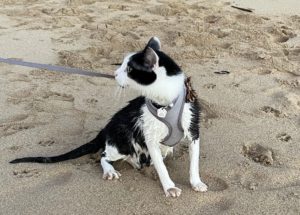
This cat’s owners told me their cat enjoys his leashed beach walks, and didn’t even mind a splash from a North Shore wave. Being leashed outdoors is all he has ever known. ©Susan Scott
Some days, the news about Hawaii’s native wildlife is so dire, I wonder if efforts toward saving it are futile. But then I have a day like Thursday at Kaena Point, where wedgie chicks lounged in their doorways, albies soared over my head, and monk seals snoozed on the rocks, and I’m reenergized.
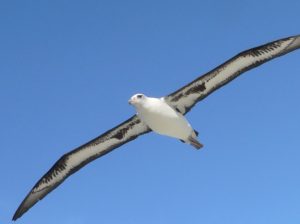
Laysan Albatrosses are experts at riding wind and air currents created by breaking waves. ©Susan Scott
For a Hawaii wildlife reboot, try a visit to Kaena Point. It worked for me.